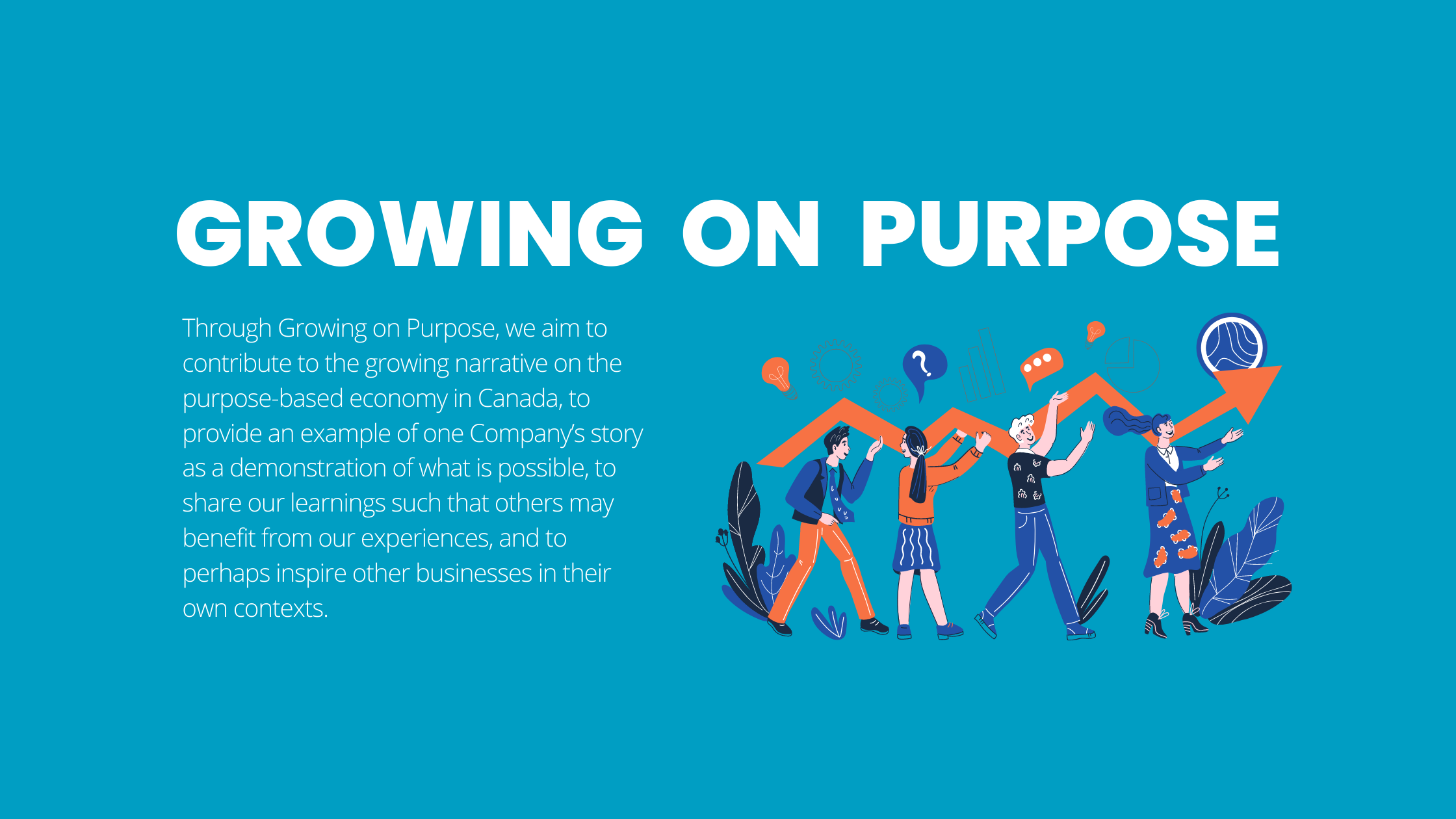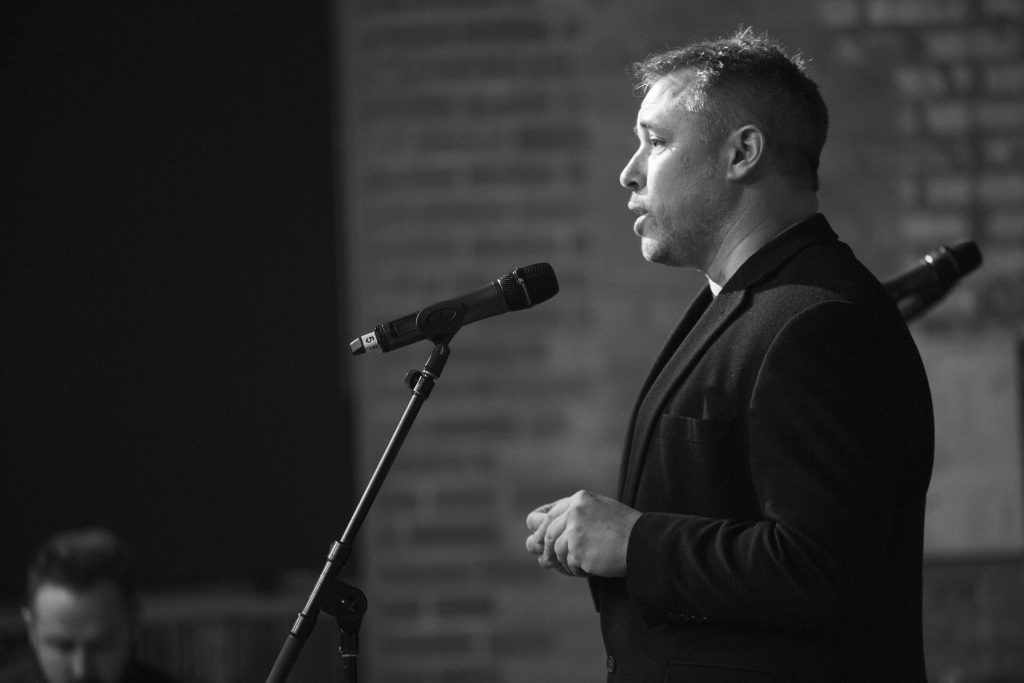
30 March 2022
Growing On Purpose
Welcome to the first instalment in our 4-part blog series Growing on Purpose, where we aspire to explore and share the evolutionary trip we’ve been on while designing and launching into our socially purposed business Urban Matters CCC.
To get us started, we’ve invited Allyson Hewitt, Vice-President Impact at the MaRS Discovery District, and leading in the creation of the Business for Purpose Network (B4PN) in partnership with the McConnell Foundation, to interview our President, Ken Gauthier, who has been at Urban Matters since its inception.
Allyson: OK Ken, what’s the backdrop here? Give us the context for launching into Urban Matters CCC.
Ken: Well, we can’t tell the Urban Matters CCC story without at least a basic overview of Urban Systems Ltd, where it all started, so bear with me for a moment here.

Urban Systems Ltd. is a multi-disciplinary professional services firm anchored in Western Canada, offering broad services in community planning and development. Launched in 1975, the firm is privately held by its employees (this becomes important later), its growth is organic and market responsive, and unlike many in its sector, it has always chosen to focus upon repeat and local client service. Their clients are predominantly municipalities, First Nations, regional and provincial governments as well as private land developers anchored in or with interests in Canada. Conservatively financed and led, it’s been financially successful every year since inception, and its culture has been recognized by the Great Places to Work Institute for 15 consecutive years, the only company to have ever done so. All in all, a great starting point for this story.
Allyson: Interesting. So it all started from the strong base of an established and successful company in Urban Systems Ltd. What changed or evolved from their perspective to open the doors for this, shall we say, experiment?
Ken: Honestly, we couldn’t have gotten this far this quickly without that strong base of support. What changed? Well, the world changed I guess, or continued to change, perhaps a little more rapidly in the past decade than in the four that preceded it.
In 2010, with the Company going through a leadership transition, the opportunity arose to revisit its core business strategy. When taking stock of what was going on in our markets and with our clients, it was obvious that the needs of our clients were evolving, and that the problems they were facing were growing much more complex. As primarily an ‘infrastructure’ firm back in those days, getting the right things built and maintaining what you have invested in was the name of the game.
It was becoming increasingly obvious, however, that wouldn’t be enough going forward. While that infrastructure need always exists, there were other dynamics at play—like who benefits from the infrastructure investments and who is excluded or adversely impacted, what kind of infrastructure was needed moving forward and what are the power dynamics at play around it, who has the social license to make the final decisions, and who is getting left behind in our communities.
A strong social development theme was emerging in our spaces, and so many other issues that communities are now grappling with, from racism to diversity, equity and inclusion, to the opioid epidemic and now to newer issues like the COVID-19 pandemic, have come to the top of the agendas of many of our client communities.
Allyson: I can totally see that. Social development needs have always been there though, for centuries; why do you suppose these were only becoming visible to your organization as late as 2010?
Ken: Good question. I want to point out that I am not suggesting that the gaps weren’t always there, just that they were becoming more and more prevalent in our day to day working environment and in those of our clients. It is tough to say specifically whether it coincided with the advent of social media raising awareness and spreading ideas and questions more rapidly than ever before, or the emergence of a new generation that saw the world a little differently and was advocating for new values in community development, or that the gradual breakdown in our social supporting systems had begun to reach a tipping point with continual population growth and income disparity, or all of the above and then some. Helping our clients solve the problems that they faced was just becoming less tangible and far more nuanced.
Allyson: Right. So, an inflection point in ‘business as usual’ for Urban Systems Ltd. I am curious as to how you collectively chose to respond, and the processes and debates that supported the decisions.
Ken: It was interesting times for sure. While this was perhaps the most significant societal shift we’d experienced since inception in 1975, we still had a decision to make: continue on the path that had served us well to date—which was probably cleaner and easier and had certainly always been sustainable and profitable—or explore how we might broaden how we support our clients as they grow and evolve, deepening our purpose, commitment and responsibility to continually strive to improve opportunities for everyone in our society.
We’re here today because we chose to try something a little different by creating a subsidiary company called Urban Matters CCC.
Allyson: Can you keep digging into that ‘why’ for me? I think its important for other companies out there to have a sense of why you would make this choice.
Ken: Interestingly enough, I believe that this all comes back to our purpose as an organization, the values that both drive Urban Systems Ltd. and that emphasize its culture, and quite frankly its central business strategy.
As a Company we have always emphasized a core commitment to the communities we serve; we have always strived toward long standing relationships with our communities and have purposefully allowed or even encouraged our business development themes to follow their needs. The aim was always to grow with our communities in Canada, rather than use our expertise to find projects in communities that suit us. It’s subtle and nuanced on the surface, but deeply profound when it plays out over a few decades and sits in relatively stark contrast to other firms in our sector that we grew up with.
In the late 90s, this deep commitment to our client communities manifested itself in the form of a charitable foundation (The Urban Systems Foundation), whereby a portion of our profits are donated and redirected toward the needs in our communities and beyond, with priorities as decided upon by our staff. So this culture of commitment, of contribution to our communities, has always been there and is continually and carefully nurtured.
All combined, aside from fit and form (relative to the incorporation model, its relationship as a subsidiary company, insurance/risk considerations, staff integration etc.), there was and is very little debate on whether we should strive to explore and have an impact in this growing need for social development. With longstanding values and purpose in place, this umbrella decision was relatively straight forward.
Allyson: So, in this case, having a well understood purpose as a business kind of legitimized this opportunity to go further, or take another step toward supporting your communities, and essentially created this new market opportunity for you?
Ken: Yes. It certainly did legitimize the notion that we ought to explore it further, although there was full recognition that this social development space was new for us, and perhaps unique relative to our previous experiences with growth. Unlike most of our evolutionary steps as an organization up to that point in time, this move required a bit more careful consideration as the market conditions around providing leadership and support in this area were (and are) a little different from say, adding a new theme in engineering to a pre-existing engineering practice, or adding an office to a new geographic market. There is a reason that there aren’t as many private sector actors participating in the social development and social innovation sectors; the issues are vast and complex, involving dozens of under-resourced actors, with messy processes and unclear progress indicators and metrics.
Allyson: I think we’d all be curious as to how you saw this new space from a business development perspective. Do tell…
Ken: Well, despite seeing many common clients, it is a vastly different space from what we’ve known conventionally. For reasons beyond the scope of this short interview, and some we still don’t understand, ‘solving’ these kinds of issues is not always the mental model through which they are approached. Or in many cases the issues are not always considered ‘solvable’ by the clients we’re engaged with. As noted, these kinds of issues are messy and often tied to macro economic trends perceived to be beyond the control of most municipalities, First Nations and even Provinces. Initially, we were questioning our entry point and whether it was too far downstream. Making progress on these issues, working on them, setting interim milestones and success measures is key, often with the recognition that we’re never going to entirely ‘solve’ them from the ground up alone; they need simultaneous top-down efforts that we have less influence over (at this juncture).
Another more unique attribute is that these kinds of issues rarely have a single owner. Unlike a client that engages with us to design and build say, a water treatment plant in community x, where we know whose jurisdiction we’re working in, there are singular and clear lines of responsibility and benefactors, working on an issue like homelessness in a community is different. There is often a dozen or more ‘owners’ of the problems, some have funding to engage us and others do not, yet all have power imbalances and political aspirations or needs of various sorts. We needed to figure out how to be an effective intermediary in that complex context.
Further related to all that is another early consideration from a pure business modelling perspective: this sector is underfunded by some margin. The ‘cost’ of solving these kinds of issues in the downstream state we find ourselves in can be perceived to be overwhelming, and rarely politically expedient. The most prevalent pathway we’ve experienced has been the treatment of the symptoms—the circumstances—rather than moving investment upstream to address root causes. As a private sector actor, we needed to come to terms with financial sustainability. We didn’t want to replicate (and compete with) the predominant model of grant or donation dependent organizations attempting to have an impact upon these issues.
I could go on for quite a few more paragraphs here, but I think that covers the highlights and gives an impression of what we were chewing on.
Allyson: OK, we’re getting into the core of this. Based upon what you learned about then, tell me more about what you did want to create, what was the nature of the opportunity your team saw?
Ken: Based upon all that we’d explored and learned about, from 2010 to say around 2013, here’s what we’d landed upon:
We wanted to create a new intermediary in the social development sector to help support communities dealing with emerging and pressing needs. A socially purposed entity through and through, that was built that way from the ground up.
We wanted to enter that space thoughtfully and responsibly. We did not want to create new competition for anyone already struggling to have an impact, rather we aspired to be seen as an actor that can help to amplify existing efforts, a partner and asset to the sector.
We wanted the freedom to eventually be working at a systems level, upstream and getting closer to root causes over just addressing symptoms. We didn’t want to exclusively be held captive to the kind of work that others see fit to fund; we wanted to work toward addressing the systemic gaps that may not be getting attention and may not be politically expedient to fund.
We wanted to create a platform where the highly trained and effective professionals can co-mingle with individuals with lived experience on the issues we’re dealing with, where their employment is secure and compensation is commensurate with the value that they bring to the situation. It sounds ridiculously ambitious, but we wanted to see if we could create a new economy around problem solving in this sector such that other actors and investment might be attracted to it.
Finally, we knew that we couldn’t expect to enter this space exclusively with our hands out waiting to get paid. Yes, financial sustainability is a foundational tenet of our ability to be present, but understanding the nature of the sector we knew that we’d also need to add value beyond our skills. We knew that we’d need to bring something new to the table beyond expertise; and we decided the next best thing we could do was bring resources to the table; yes, money.
Allyson: That’s a tall order, nothing like being a little ambitious!
Ken: For sure it is, and I can’t say we’ve entirely checked all those boxes yet, but we’re on our way. While ambitious, we have lots of advantages too, so I feel that it was incumbent upon us to aim high.
By 2013-2014 we’d made the decision to launch some kind of satellite into this social development space as a means to go further with our clients, and to demonstrate leadership and participation in this growing domain of complexity that our clients had been struggling with. We had some research behind us, some experiences working with boards of non-profit organizations as volunteers, a great network of supporters and advisors who went to lengths to open doors for us and get us networked, and a lot of hope and passion.
Our aim was to invest a few years worth of effort in learning its nature, subtleties, nuances and intricacies, while simultaneously applying that learning in adjusting our approach and pivoting on the fly. This ultimately led us to create a subsidiary company in 2014, Urban Matters CCC, a hybrid business model called a Community Contribution Company (only available in BC at the moment, with something similar in Nova Scotia), along with a new brand and identify to support it —but that’s the subject of our next edition in this blog series.
Allyson: OK, good to know because I’d really want to ask a bunch of questions about that too. To summarize for this session and before I let you go, what would you say were the pre-conditions or unique circumstances that allowed for this to happen? I think other businesses out there might benefit from understanding how this all came together.
Ken: For sure. I’ve been thinking about that a lot and wondering whether our circumstances were so unique that this ‘experiment’ really doesn’t possess many replicable attributes. Generally, I’ve landed on two key fundamental factors that really made this happen: a clear and well understood purpose as an organization and leadership that is bold and committed to that purpose. With that in place, I think any business could replace some version of this story in their own context.
We’ve benefitted from some additional advantages that played in our favour as well, and which are perhaps less replicable and always worth noting. Despite a strong organizational purpose and orientation, taking steps in this direction were also coincidentally supported by very positive organizational circumstances at the time.
First off, the organization was in a strong position financially speaking. It was confident, had emerged from the 2008 financial crisis in relatively good shape and was relaunching itself into a refreshed mandate with renewed leadership. Confidence, even traces of boldness, could be conjured up as we looked to make a mark as an emerging generation of leadership at the firm.
Also, the organizational culture was and remains largely trust based. It emphasizes freedom and accountability in its relationship with all of its staff. Based upon that trust, the leadership that emerged to spearhead this initiative (myself included) was afforded space to rapidly pilot, learn and explore the space.
Indirectly, I think being a privately held company was also a key circumstantial attribute that worked in our favour; particularly when contrasted to the many larger publicly traded professional service firms that aspire to participate in community problem solving of this nature. Being privately held allowed us to make our investment and risk decisions for ourselves. Opening the conversations to public shareholders who would generally be as interested in financial return as any other attribute of the firm, would, of course, invoke a much wider perspective on the approach to take, and whether to pursue this investment avenue at all.
Allyson: Privately held, you had mentioned that earlier, that’s an interesting angle and I can totally see the opportunity that presents as well.
Ken: Absolutely. I don’t think a publicly traded organization is a lost opportunity though, and arguably moving the needle with large public traded actors is probably the most impactful pathway we can follow given their breadth and reach. But it sure was an advantage working within the context of stakeholders that are aligned with the organization’s culture and its values, including but not limited to financial return on investment.
Allyson: Really interesting stuff Ken, thanks for taking the time to share this out with us all, its the really juicy stuff that we don’t often get to hear too much about. I am looking forward to the next segments!
Ken: Thank you Allyson, for taking the time and asking the questions that matter. We’d be happy to expand upon any of this for interested parties out there, just reach out at kgauthier@urbanmatters.ca. If any readers are interested in learning more about purpose in business in general, they can tune into the Business For Purpose Network (the B4PN!) and its weekly newsletter at Mars.com/service/business-for-purpose-network.

ALLYSON HEWITT, Vice-President Impact. MaRS Discovery District, Toronto, Canada. Allyson has assisted hundreds of social ventures to become economically sustainable and increase their social impact. For 10 years she led Social Innovation Generation (SiG) at MaRS which helped create a culture of social innovation in Canada. Over that time she helped develop, and still supports, many programs including the Centre for Impact Investing; the Solutions Lab; and Studio ]Y].
Allyson is also working with the McConnell Foundation to engage corporate Canada in solving our most complex challenges through the creation of the Business for Purpose Network. She was one of 17 members of a federal government steering group that co-created a social innovation and social finance strategy for Canada. One of the recommendations from that group resulted in a $805M contribution to social finance over ten years from the federal government.
Allyson has also enjoyed up her experience as the Thinker in Residence for the Social Capital Residency in South Australia; she is a lecturer in social entrepreneurship and corporate social responsibility at the University of Waterloo; and she is the Impact Faculty member at SingularityU Canada.
Allyson’s social innovation is 211 which has just been made available across the country due to COVID funding. Her academic background is in Criminology, Law, Public Affairs, Voluntary Sector Management and she is certified as a coach.




